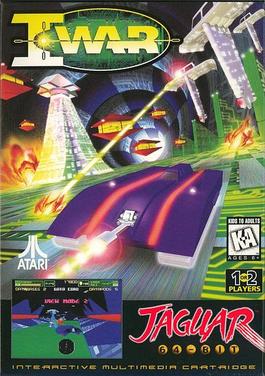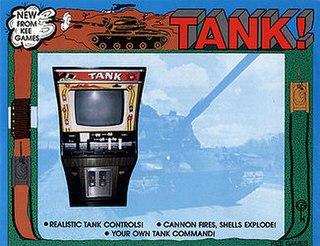
Atari is a brand name that has been owned by several entities since its inception in 1972. It is currently owned by French holding company Atari SA. The original Atari, Inc., founded in Sunnyvale, California, United States in 1972 by Nolan Bushnell and Ted Dabney, was a pioneer in arcade games, home video game consoles, and home computers. The company's products, such as Pong and the Atari 2600, helped define the electronic entertainment industry from the 1970s to the mid-1980s.

The Atari 2600 is a home video game console developed and produced by Atari, Inc. Released in September 1977 as the Atari Video Computer System, it popularized microprocessor-based hardware and games stored on swappable ROM cartridges, a format first used with the Fairchild Channel F in 1976. The VCS was bundled with two joystick controllers, a conjoined pair of paddle controllers, and a game cartridge—initially Combat and later Pac-Man. Sears sold the system as the Tele-Games Video Arcade. Atari rebranded the VCS as the Atari 2600 in November 1982, alongside the release of the Atari 5200.
The video game crash of 1983 was a large-scale recession in the video game industry that occurred from 1983 to 1985 in the United States. The crash was attributed to several factors, including market saturation in the number of video game consoles and available games, many of which were of poor quality. Waning interest in console games in favor of personal computers also played a role. Home video game revenue peaked at around $3.2 billion in 1983, then fell to around $100 million by 1985. The crash abruptly ended what is retrospectively considered the second generation of console video gaming in North America. To a lesser extent, the arcade video game market also weakened as the golden age of arcade video games came to an end.

Missile Command is a 1980 shoot 'em up video game developed and published by Atari for arcades. Sega released the game outside North America. It was designed by Dave Theurer, who also designed Atari's vector graphics game Tempest from the same year. The game was released during the Cold War, and the player uses a trackball to defend six cities from intercontinental ballistic missiles by launching anti-ballistic missiles from three bases.
The following article is a broad timeline of arcade video games.
1975 saw several critical influences in the history of video games, including the first commercial games utilizing large-scale integrated circuits and microprocessors, as well as the first role-playing video games.

I-War is a 1995 shooter video game developed by Imagitec Design and published by Atari Corporation for the Atari Jaguar. The plot takes place in a futuristic setting where the mainframe supercomputer Override begins to mutate databases and create computer viruses. The player is tasked with piloting an antivirus tank vehicle to eliminate mutated databases and viruses clogging the I-Way network, while recovering data pods and facing off against a variety of enemies.

The Atari Flashback is a line of dedicated video game consoles produced since 2004, currently designed, produced, published and marketed by AtGames under license from Atari SA. The Flashback consoles are "plug-and-play" versions of the 1970s Atari 2600 console with built-in games rather than using ROM cartridges. The latest home console model, Atari Flashback 12 Gold, was released in 2023 and has 130 games.

Alien vs Predator is a 1994 first-person shooter developed by Rebellion Developments and published by Atari Corporation for the Atari Jaguar. It was also distributed in Japan by Mumin Corporation, where it became a pack-in game for the console. It is the first entry in the Alien vs. Predator franchise developed by Rebellion. Taking place in a simulation depicting the fall of the Golgotha training base camp, the game offers three playable scenarios: Alien, Predator, or a human of the Colonial Marines. The player is presented with a series of interconnected sublevels and ships to progress through. Each character has different objectives, abilities, weapons, and disadvantages.

Tank is an arcade game developed by Kee Games, a subsidiary of Atari, and released in November 1974. It was one of the few original titles not based on an existing Atari property developed by Kee Games, which was founded to sell clones of Atari games to distributors as a fake competitor prior to the merger of the two companies. In the game, two players drive tanks through a maze viewed from above while attempting to shoot each other and avoid mines, represented by X marks, in a central minefield. Each player controls their tank with a pair of joysticks, moving them forwards and back to drive, reverse, and steer, and firing shells with a button to attempt to destroy the other tank. The destruction of a tank from a mine or shell earns the opposing player a point, and tanks reappear after being destroyed. The winner is the player with more points when time runs out, with each game typically one or two minutes long.

Cybermorph is a shooter video game developed by Attention to Detail (ATD) and published by Atari Corporation as the pack-in game for the Atari Jaguar in North America on November 23, 1993, and Europe in June 1994. It was also distributed in Japan by Mumin Corporation as a stand-alone release. Taking place in a galactic war, the player pilots the morphing attack fighter TransmoGriffon to battle against the Pernitia empire, who have conquered planets on multiple sectors and whose regenerative robotic technology become entrenched into the planets. The player is tasked with recapturing critical pods, while facing against enemies and bosses, across five sectors in order to defeat the empire.
The Lord of the Rings: Journey to Rivendell was a video game scheduled to be released in the winter of 1983. Parker Brothers was set to publish it, and advertised it in their 1982 and 1983 catalogues as a game that would be released on the Atari 2600 and Atari 8-bit computers. The game was originally advertised under the name Lord of the Rings, and in one case as The Lord of the Rings I. It was described as an adventure of getting Frodo from the Shire to the door at Moria, a description which was later changed in the 1983 Parker Brothers Video Games catalogue to have Rivendell as the adventures end point instead. The same catalogue was first time the game was ever referred to as The Lord of the Rings: Journey to Rivendell, and was the last advertisement the game ever received. The game was never released, and it was believed that little or no work was done on the game's coding.

The Atari video game burial was a mass burial of unsold video game cartridges, consoles, and computers in a New Mexico landfill site undertaken by the American video game and home computer company Atari, Inc. in 1983. Before 2014, the goods buried were rumored to be unsold copies of E.T. the Extra-Terrestrial (1982), one of the largest commercial video game failures and often cited as one of the worst video games ever released, and the 1982 Atari 2600 port of Pac-Man, which was commercially successful but critically maligned.
Non-games are a class of software on the border between video games and toys. The term "non-game game" was coined by late Nintendo president Satoru Iwata, who describes it as "a form of entertainment that really doesn't have a winner, or even a real conclusion". Will Wright had previously used the term "software toy" for the same purpose. The main difference between non-games and traditional video games is the lack of structured goals, objectives, and challenges. This allows the player a greater degree of self-expression through freeform play, since they can set up their own goals to achieve. Some genres that have been considered non-games include language-learning software, digital tabletop games, puzzle games, simulation games, and art games.
Atari, Inc. is an American video gaming company based in New York City, and a subsidiary of the Atari SA holding company. It is the main entity serving the commercial Atari brand globally since 2003. The company currently publishes games based on retro Atari franchises as well as some new content, and also produces the new Atari 2600+ console. In the past it produced titles including Neverwinter Nights, Driver 3, Fahrenheit, RollerCoaster Tycoon 3 and Test Drive Unlimited.

Atari, Inc. was an American video game developer and home computer company founded in 1972 by Nolan Bushnell and Ted Dabney. Atari was a key player in the formation of the video arcade and video game industry.

Substation is a first-person shooter released for the Atari STe in 1995 by Unique Development Sweden. The game is set in an underwater base that has been overrun by aliens. The game was previewed in the British ST Format, later receiving a 75%, was given a 7/10 from the French magazine STart Micro, received 80% from the German magazine ST-Computer, and was reviewed in the French ST Magazine.
Hellgate is a first-person shooter released for the Atari STe in 1997. The game was written in STOS BASIC by David Walters. The game received a complimentary review from the Atari Times. The game's source code was released under the MIT license in 2022.










